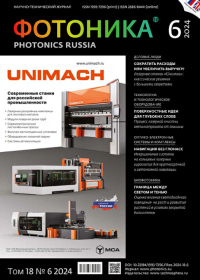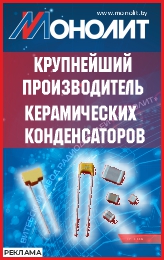Business People
A. M. Tyazhlov
Unimach Laser Machines: Business Effects for Users DOI: 10.22184/1993-7296.FRos.2024.18.6.428.432
Unimach Laser Machines: Business Effects for Users DOI: 10.22184/1993-7296.FRos.2024.18.6.428.432
Technologies and Technology Equipment
D. V. Zhurba, V. M. Zhurba, V. P. Veiko, A. E. Puisha
Investigation of the Process of Laser Descaling of Rolled Metal DOI: 10.22184/1993-7296.FRos.2024.18.6.436.449
The article investigates the process of laser cleaning of mill metal in exposure modes that do not lead to heating of the scale above its melting point. The possibility of destruction of mill scale due to thermochemical reactions in the scale and subsequent thermomechanical destruction has been identified and substantiated. The search and optimization of laser exposure modes has been carried out to increase the cleaning efficiency. For a more complete description of the laser cleaning process, attention is paid to the structure of mill scale; the features of its formation and probable phase transformations under the action of laser heating are described. An area of laser treatment modes in the range of exposure durations from 30 to 400 µs and power densities of from 50 to 750 kW/cm2 leading to thermomechanical scale destruction has been experimentally discovered. The process of laser descaling due to thermomechanical destruction is implemented using a continuous-wave fiber ytterbium laser with a maximum power of 2 kW.
Investigation of the Process of Laser Descaling of Rolled Metal DOI: 10.22184/1993-7296.FRos.2024.18.6.436.449
The article investigates the process of laser cleaning of mill metal in exposure modes that do not lead to heating of the scale above its melting point. The possibility of destruction of mill scale due to thermochemical reactions in the scale and subsequent thermomechanical destruction has been identified and substantiated. The search and optimization of laser exposure modes has been carried out to increase the cleaning efficiency. For a more complete description of the laser cleaning process, attention is paid to the structure of mill scale; the features of its formation and probable phase transformations under the action of laser heating are described. An area of laser treatment modes in the range of exposure durations from 30 to 400 µs and power densities of from 50 to 750 kW/cm2 leading to thermomechanical scale destruction has been experimentally discovered. The process of laser descaling due to thermomechanical destruction is implemented using a continuous-wave fiber ytterbium laser with a maximum power of 2 kW.
Tags: лазерная очистка микросекундная длительность воздействия непрерывный иттербиевый волоконный лазер прокатная окалина термомеханическое разрушение окалины
Opto-electronic systems and complexes
A. O. Sinelnikov, N. V. Tikhmenev, A. A. Ushanov, V. M. Medvedev
State-of-the-Art and Development Trends of Inertial Navigation Systems Based on the Ring Laser Gyroscopes DOI: 10.22184/1993-7296.FRos.2024.18.6.450.466
The article summarizes and analyzes information on the batch-produced high-end inertial navigation systems. The market dynamics for the high-end inertial systems and gyro pickups over the past 10 years are given. The dominance of inertial systems based on the ring laser gyroscopes for the mid-term and autonomous navigation is shown. The prevailing design and technological solutions of modern ring laser gyroscopes are considered. The similarity of foreign devices due to the optico-physical circuit is noted. The key developers of laser inertial systems are identified. A trend towards the reduced weight and dimensional specifications, decreased cost and energy consumption of the ring laser gyroscopes while maintaining the required accuracy and resistance to the external influences is shown.
State-of-the-Art and Development Trends of Inertial Navigation Systems Based on the Ring Laser Gyroscopes DOI: 10.22184/1993-7296.FRos.2024.18.6.450.466
The article summarizes and analyzes information on the batch-produced high-end inertial navigation systems. The market dynamics for the high-end inertial systems and gyro pickups over the past 10 years are given. The dominance of inertial systems based on the ring laser gyroscopes for the mid-term and autonomous navigation is shown. The prevailing design and technological solutions of modern ring laser gyroscopes are considered. The similarity of foreign devices due to the optico-physical circuit is noted. The key developers of laser inertial systems are identified. A trend towards the reduced weight and dimensional specifications, decreased cost and energy consumption of the ring laser gyroscopes while maintaining the required accuracy and resistance to the external influences is shown.
Tags: инерциальная навигационная система инерциальный датчик инерциальный измерительный блок кольцевой лазерный гироскоп оптический гироскоп резонансный гироскоп
Fiber Optic Devices & Technoligies
S. B. Bychkov, А. О. Pogonyshev, S. V. Tikhomirov, V. R. Sumkin
Methods for Measuring Return Loss in Fiber Optic Lines and Сomponents DOI: 10.22184/1993-7296.FRos.2024.18.6.470.484
This article discusses 3 methods for measuring of optic return loss (ORL) in fiber optic systems being used in modern measuring instruments: continuous wave method (CW), time domain reflectometry (OTDR) and frequency domain reflectometry (OFDR). The authors perform a comparative analysis of these methods, and consider the advantages and limitations of these methods.
Methods for Measuring Return Loss in Fiber Optic Lines and Сomponents DOI: 10.22184/1993-7296.FRos.2024.18.6.470.484
This article discusses 3 methods for measuring of optic return loss (ORL) in fiber optic systems being used in modern measuring instruments: continuous wave method (CW), time domain reflectometry (OTDR) and frequency domain reflectometry (OFDR). The authors perform a comparative analysis of these methods, and consider the advantages and limitations of these methods.
Tags: measurements metrological support ofdr optical return loss orl otdr reflectometry измерение метрологическое обеспечение оптические обратные потери рефлектометрия
Biophotonics
O. V. Shelepova, E. N. Baranova, K. A. Sudarikov, L. S. Olekhnovich, L. N. Konovalova, V. V. Latushkin, P. A. Vernik, A. A. Gulevich
Evaluation of the Use of LED Lighting in Combination with the Use of γ-PGA SAP Peptide on the Growth and Development of Peppermint Plants in a Closed Biosystem DOI: 10.22184/1993-7296.FRos.2024.18.6.486.498
The article shows the possibility of regulating the biomass and productivity of Mentha piperita L. when grown in a closed Synergotron system. The results of the influence of modulation of light cultivation parameters and the use of treatments with low concentrations of the peptide due to changes in the intensity of growth and the formation of vegetative mass are presented. It has been established that the closed system makes it possible to identify subtle mechanisms of changes in plants and their morphology and metabolism when using the vegetation indices GLI, EXG, VARI and traditional criteria for assessing productivity, opening up new opportunities in the development of modern approaches in the biotechnology of essential oil plants.
Evaluation of the Use of LED Lighting in Combination with the Use of γ-PGA SAP Peptide on the Growth and Development of Peppermint Plants in a Closed Biosystem DOI: 10.22184/1993-7296.FRos.2024.18.6.486.498
The article shows the possibility of regulating the biomass and productivity of Mentha piperita L. when grown in a closed Synergotron system. The results of the influence of modulation of light cultivation parameters and the use of treatments with low concentrations of the peptide due to changes in the intensity of growth and the formation of vegetative mass are presented. It has been established that the closed system makes it possible to identify subtle mechanisms of changes in plants and their morphology and metabolism when using the vegetation indices GLI, EXG, VARI and traditional criteria for assessing productivity, opening up new opportunities in the development of modern approaches in the biotechnology of essential oil plants.
News

 rus
rus TS_pub
TS_pub technospheramag
technospheramag technospheramag
technospheramag ТЕХНОСФЕРА_РИЦ
ТЕХНОСФЕРА_РИЦ


